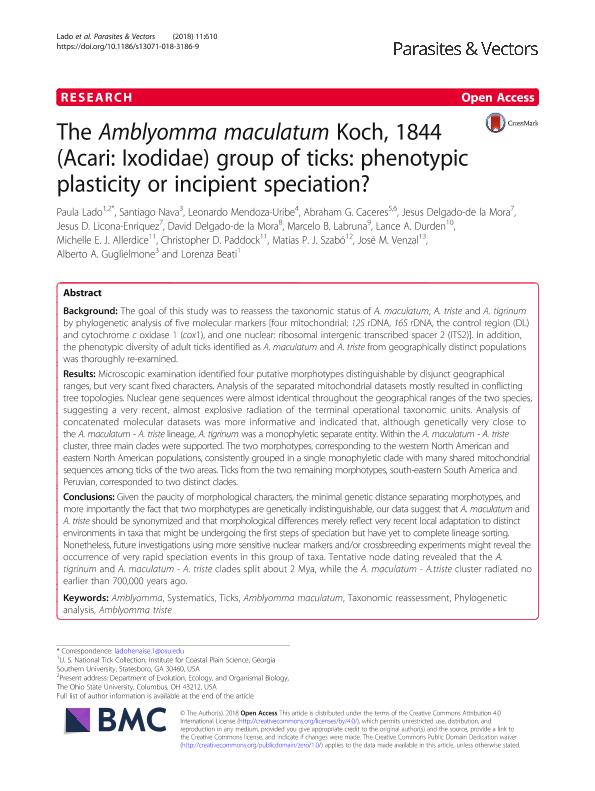Artículo
The Amblyomma maculatum Koch, 1844 (Acari: Ixodidae) group of ticks: Phenotypic plasticity or incipient speciation?
Lado, Paula; Nava, Santiago ; Mendoza Uribe, Leonardo; Caceres, Abraham G.; Delgado de la Mora, Jesus; Licona Enriquez, Jesus D.; Delgado de la Mora, David; Labruna, Marcelo B.; Durden, Lance A.; Allerdice, Michelle E. J.; Paddock, Christopher D.; Szabó, Matias P. J.; Venzal, José M.; Guglielmone, Alberto Alejandro
; Mendoza Uribe, Leonardo; Caceres, Abraham G.; Delgado de la Mora, Jesus; Licona Enriquez, Jesus D.; Delgado de la Mora, David; Labruna, Marcelo B.; Durden, Lance A.; Allerdice, Michelle E. J.; Paddock, Christopher D.; Szabó, Matias P. J.; Venzal, José M.; Guglielmone, Alberto Alejandro ; Beati, Lorenza
; Beati, Lorenza
 ; Mendoza Uribe, Leonardo; Caceres, Abraham G.; Delgado de la Mora, Jesus; Licona Enriquez, Jesus D.; Delgado de la Mora, David; Labruna, Marcelo B.; Durden, Lance A.; Allerdice, Michelle E. J.; Paddock, Christopher D.; Szabó, Matias P. J.; Venzal, José M.; Guglielmone, Alberto Alejandro
; Mendoza Uribe, Leonardo; Caceres, Abraham G.; Delgado de la Mora, Jesus; Licona Enriquez, Jesus D.; Delgado de la Mora, David; Labruna, Marcelo B.; Durden, Lance A.; Allerdice, Michelle E. J.; Paddock, Christopher D.; Szabó, Matias P. J.; Venzal, José M.; Guglielmone, Alberto Alejandro ; Beati, Lorenza
; Beati, Lorenza
Fecha de publicación:
11/2018
Editorial:
BioMed Central
Revista:
Parasites and Vectors
ISSN:
1756-3305
Idioma:
Inglés
Tipo de recurso:
Artículo publicado
Clasificación temática:
Resumen
Background: The goal of this study was to reassess the taxonomic status of A. maculatum, A. triste and A. tigrinum by phylogenetic analysis of five molecular markers [four mitochondrial: 12S rDNA, 16S rDNA, the control region (DL) and cytochrome c oxidase 1 (cox1), and one nuclear: ribosomal intergenic transcribed spacer 2 (ITS2)]. In addition, the phenotypic diversity of adult ticks identified as A. maculatum and A. triste from geographically distinct populations was thoroughly re-examined. Results: Microscopic examination identified four putative morphotypes distinguishable by disjunct geographical ranges, but very scant fixed characters. Analysis of the separated mitochondrial datasets mostly resulted in conflicting tree topologies. Nuclear gene sequences were almost identical throughout the geographical ranges of the two species, suggesting a very recent, almost explosive radiation of the terminal operational taxonomic units. Analysis of concatenated molecular datasets was more informative and indicated that, although genetically very close to the A. maculatum - A. triste lineage, A. tigrinum was a monophyletic separate entity. Within the A. maculatum - A. triste cluster, three main clades were supported. The two morphotypes, corresponding to the western North American and eastern North American populations, consistently grouped in a single monophyletic clade with many shared mitochondrial sequences among ticks of the two areas. Ticks from the two remaining morphotypes, south-eastern South America and Peruvian, corresponded to two distinct clades. Conclusions: Given the paucity of morphological characters, the minimal genetic distance separating morphotypes, and more importantly the fact that two morphotypes are genetically indistinguishable, our data suggest that A. maculatum and A. triste should be synonymized and that morphological differences merely reflect very recent local adaptation to distinct environments in taxa that might be undergoing the first steps of speciation but have yet to complete lineage sorting. Nonetheless, future investigations using more sensitive nuclear markers and/or crossbreeding experiments might reveal the occurrence of very rapid speciation events in this group of taxa. Tentative node dating revealed that the A. tigrinum and A. maculatum - A. triste clades split about 2 Mya, while the A. maculatum - A.triste cluster radiated no earlier than 700,000 years ago.
Archivos asociados
Licencia
Identificadores
Colecciones
Articulos(CCT - SANTA FE)
Articulos de CTRO.CIENTIFICO TECNOL.CONICET - SANTA FE
Articulos de CTRO.CIENTIFICO TECNOL.CONICET - SANTA FE
Citación
Lado, Paula; Nava, Santiago; Mendoza Uribe, Leonardo; Caceres, Abraham G.; Delgado de la Mora, Jesus; et al.; The Amblyomma maculatum Koch, 1844 (Acari: Ixodidae) group of ticks: Phenotypic plasticity or incipient speciation?; BioMed Central; Parasites and Vectors; 11; 11-2018; 1-22; 610
Compartir
Altmétricas



